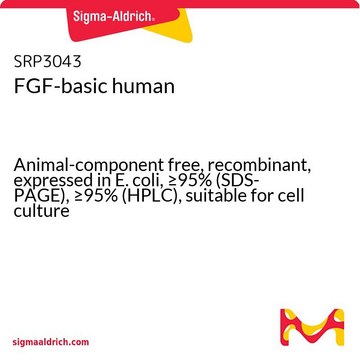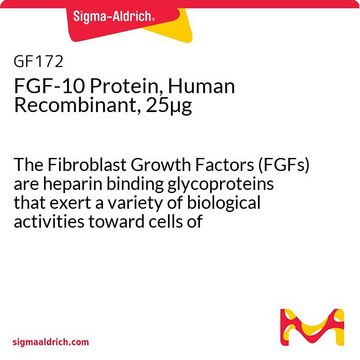F8424
Fibroblast Growth Factor-4 human
≥95% (SDS-PAGE and HPLC), recombinant, expressed in E. coli, lyophilized powder, suitable for cell culture
Sinónimos:
hFGF-4, FGF-4, K-FGF
About This Item
Productos recomendados
product name
Fibroblast Growth Factor-4 human, FGF-4, recombinant, expressed in E. coli, lyophilized powder, suitable for cell culture
biological source
human
Quality Level
recombinant
expressed in E. coli
assay
≥95% (SDS-PAGE and HPLC)
form
lyophilized powder
potency
≤10.0 ng/mL
quality
endotoxin tested
mol wt
19 kDa
packaging
pkg of 25 and 100 μg
storage condition
avoid repeated freeze/thaw cycles
technique(s)
cell culture | mammalian: suitable
impurities
<1 EU/μg
UniProt accession no.
storage temp.
−20°C
Gene Information
human ... FGF4(2249) , FGF4(2249)
¿Está buscando productos similares? Visita Guía de comparación de productos
General description
Application
- To maintain trophectoderm stem cells.
- In neurogenic differentiation.
- In hepatocyte differentiation.
Biochem/physiol Actions
Physical form
Analysis Note
Storage Class
11 - Combustible Solids
wgk_germany
WGK 3
flash_point_f
Not applicable
flash_point_c
Not applicable
ppe
Eyeshields, Gloves, type N95 (US)
Certificados de análisis (COA)
Busque Certificados de análisis (COA) introduciendo el número de lote del producto. Los números de lote se encuentran en la etiqueta del producto después de las palabras «Lot» o «Batch»
¿Ya tiene este producto?
Encuentre la documentación para los productos que ha comprado recientemente en la Biblioteca de documentos.
Artículos
Fibroblast growth factors in cell culture and various growth factors for your research
Nuestro equipo de científicos tiene experiencia en todas las áreas de investigación: Ciencias de la vida, Ciencia de los materiales, Síntesis química, Cromatografía, Analítica y muchas otras.
Póngase en contacto con el Servicio técnico







